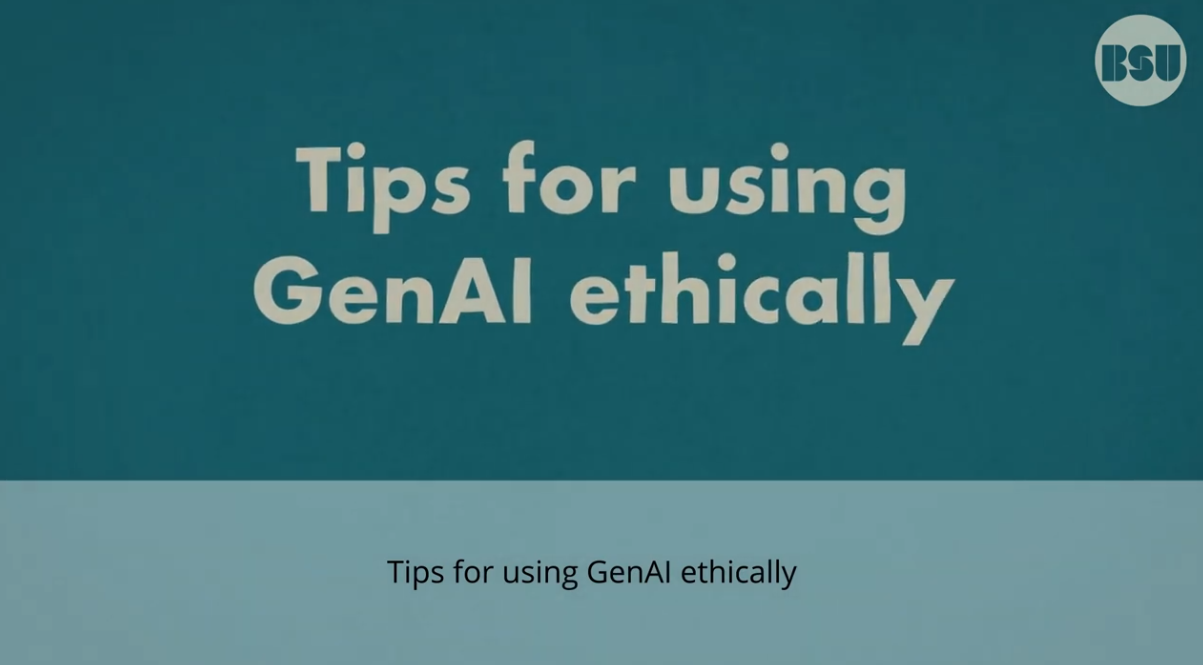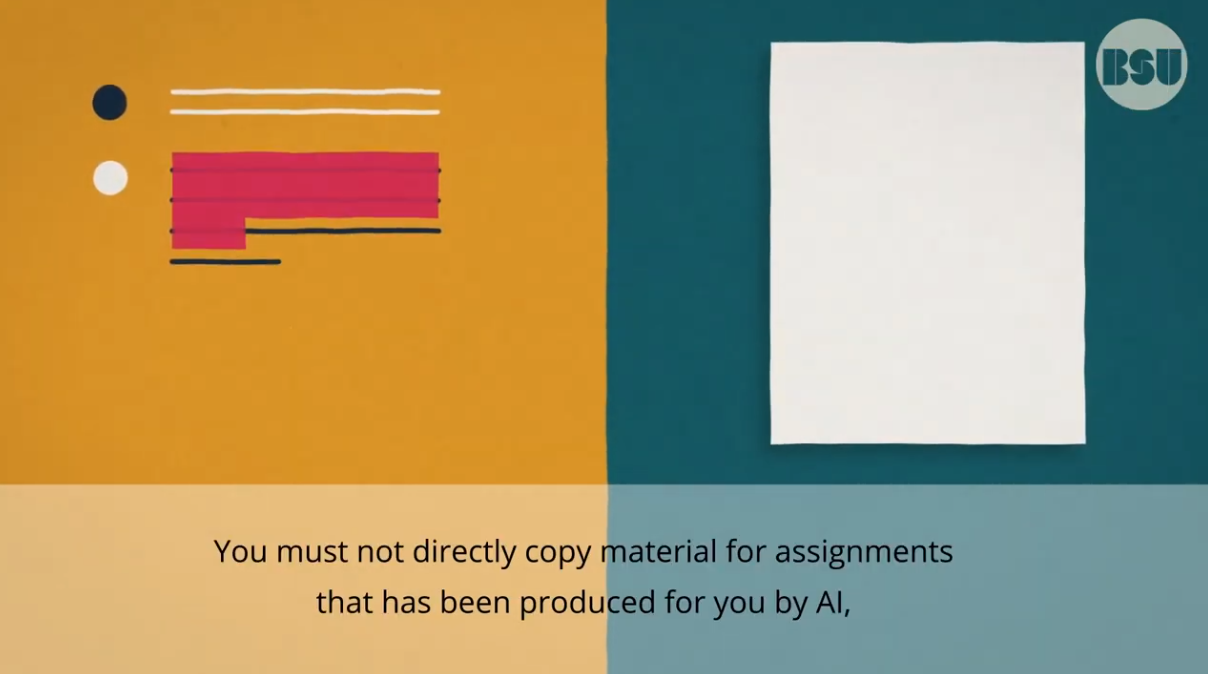Guidance for students on the use of generative AI
In this section we'll cover what Generative AI (GenAI) is, tips on how to use it as a student effectively and with integrity, what are the pros and cons of its use at university, and how to get more help if you need it
Pros and cons of using AI at university
Benefits
Planning: Using GenAI can have many benefits and can be particularly helpful in the brainstorming and planning stages of working on an assignment. You can ask Generative AI for topic suggestions, feedback on ideas, or help writing emails.
Personalisation: GenAI can also customise and personalise learning materials to meet your individual learning style, for example by converting a written piece into a conversational podcast or breaking down complex ideas into bitesize chunks, as well as assisting learners with additional or alternative learning requirements by providing accessible formats.
Availability: GenAI doesn't have office hours, meaning you're able to use it outside of core business hours as an additional learning tool.
What tools can I use?Drawbacks
It's important to also remember that this technology has numerous drawbacks relating to ethics, sustainability, creativity, security and privacy and more.
Skills development: It can lead to superficial engagement with the learning material, and research has found that over-reliance on AI tools can potentially erode critical thinking skills as well as accelerate skill decay and hinder skill development.
Bias and plagiarism: It can reflect biases in its training data, leading to bias in the output. The data the AI was trained on may also have been plagiarised.
Sustainability: AI is also much more intensive than other forms of internet/computer usage, using huge amounts of energy to power and water to cool servers.
Privacy: There are concerns around data privacy when using tools not provided by the university, such as ChatGPT.
Fake information: Most importantly, GenAI can invent facts that seem plausible (‘hallucinations’), therefore you must check everything it says with a reputable source, such as resources from the Library like academic journals and textbooks. Think of GenAI as a bit like Wikipedia – it's a helpful starting point, but your evidence should come from the reputable sources you've used to check those facts.
Cautions and Ethical ConsiderationsTips for using GenAI as a student
Think about your privacy
Always be mindful of the information you share online, including with AI platforms. Make sure you don’t share personal, sensitive, or confidential details.
If a tool is free, you can assume that all the prompts, questions, images, videos and responses you enter are saved as chat history; details about your device, browser, location and IP address may be collected.
This is why the university recommends Copilot. As the university pays for Copilot, your data is more secure than when using other forms of AI. Copilot encrypts your chat data; prompts and responses are not retained after the session ends; nobody at Microsoft can view your conversations; and the data from your chats is not used to train the underlying AI models.
Consider how much text to use
An AI writing generator might produce phrases that you think would translate well to your writing – but how much of these should you use? We think it's reasonable to base the extent to which you can copy and paste from a tool such as Copilot, on how much is acceptable to copy and paste from a source such as the Academic Phrasebank, which is widely used in academic circles. This means that you can copy word-for-word, without referencing, sentence fragments that don't contain facts. These should be no more than 5-8 words long, and you should limit the amount of these: it is suggested that you use a maximum of 3 of these per 150-word paragraph.
Get help with planning
If you have been given permission to use GenAI, it can be most helpful in the planning stages of your work.
The more information you add to your prompts, the better and more specific the responses you receive will be.
Rather than asking it for a list of topic ideas, you could provide a list of topics that you plan to cover and ask it for feedback or further suggestions.
Ask for feedback
You can also ask GenAI for feedback on what you've written, and the more specific you can be the better. For example, you could give Copilot a section of your writing and ask questions such as:
- ‘I often get feedback on XXX, what feedback on XXX would you give me for this piece of writing?’
- ‘How strong is my argument?’
- ‘Do I have enough evidence?’
- ‘Do my ideas come across clearly?’
- ‘How good are my topic sentences?’
- ‘How good are my linking sentences?’
Remember that GenAI hasn’t studied your subject, at your university, with your lecturers. Use your own judgement and critical thinking skills to assess any recommendations it makes.
Get help with your academic reading
You can cut and paste a section of open access text into Copilot and ask for a summary to help you understand the original. Open access texts are freely available academic resources that you can use without any copyright restrictions.
AI use and copyright
Guidelines for copying any text or image or part thereof into any AI tool
You must ensure one of the conditions applies:
- You have consent from the owner
- The content is no longer under copyright
- The copyright holder of the content/text/image has explicitly licensed the use of their material by AI tools, to the extent to which you intend to use their material (e.g. commercially or non-commercially, for standalone analysis or for training large language models)
If you are not sure the content, text or image is under copyright you must assume it is.
Generation of images and sounds
AI tools such as Adobe’s Firefly can also generate images and audio which might serve as starting points for projects. As in many subjects, art, design, film and media tutors value creativity and originality, so you should check your lecturers' specific recommendations for individual assignments.
Using generative AI ethically at university involves being mindful of the information shared online and ensuring that AI-generated content is cross-checked with reliable sources. Students should use AI tools for feedback and planning while maintaining academic integrity by avoiding plagiarism and properly citing any AI-assisted work.
Academic integrity and GenAI
Can the University detect AI-generated writing?
At Bath Spa we have no current plans to use AI detection tools as they are currently inaccurate; the writing produced by GenAI can often be identified by its bland and repetitive nature. Lecturers will also be looking for work that's beyond your current capability, or expressed in a way that's clearly different to your normal style.
If your lecturer suspects that your assignment contains larger sections that have been pasted from AI, they'll first have an informal chat with you to find out more about how you produced your work. This means you'll need to be able to discuss and show understanding of the concepts and evidence that you've presented in your essay.
You must not directly copy larger chunks of text or images that have been produced for you by AI without attributing the source, as this will count as ‘passing off the work of another as your own’ and is against our academic integrity policy. This includes using the AI function in Grammarly to rewrite whole sentences.
Include references and an appendix
If you choose to copy and paste a large amount of text from GenAI, it is important to cite this correctly as outlined in Cite them Right.
If you use any generative AI tools at any stage of your assessment, include information on how you have used it as an appendix at the end of your piece of work.
Include the following information as an appendix at the end of your assessed piece of work. The appendix should name the generative AI tool(s) you have used and summarise how you have used them.
For example (select all that apply):
- I acknowledge the use of <insert name(s) and url> to generate information for background research.
- I acknowledge the use of <insert name(s) and url> at the drafting stage of the writing process with the creation of an outline structure for this essay.
- I acknowledge the use of <insert name(s) and url> to identify improvements in the writing style.
- I acknowledge the use of <insert name(s) and url> as an information source to generate materials that were included within my final assessment in my own words.
- I acknowledge the use of <insert name(s) and url> to create the images included in this presentation.
- No content generated by AI technologies has been presented as my own work


